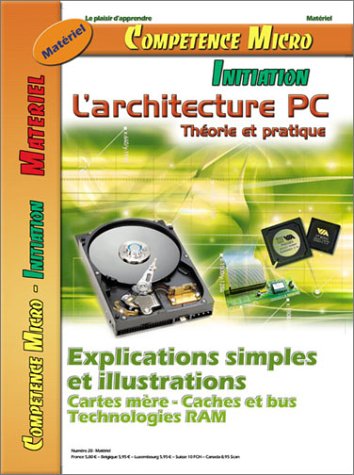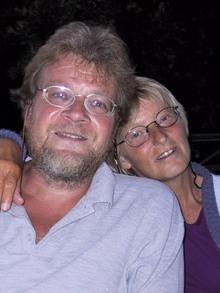
PC Architecture
Written in easy language and contains 45 chapters with a lot of illustrations. Requires some practical experience with PC’s and familiarity with the most basic computer jargon (bits, bytes, RAM, etc.).
Publication date: 01 Mar 2005
ISBN-10: n/a
ISBN-13: n/a
Paperback: n/a
Views: 70,710
Type: N/A
Publisher: n/a
License: n/a
Post time: 08 Mar 2007 05:25:12
PC Architecture
 Written in easy language and contains 45 chapters with a lot of illustrations. Requires some practical experience with PC’s and familiarity with the most basic computer jargon (bits, bytes, RAM, etc.).
Written in easy language and contains 45 chapters with a lot of illustrations. Requires some practical experience with PC’s and familiarity with the most basic computer jargon (bits, bytes, RAM, etc.).
Tag(s):
Computer Organization and Architecture
Publication date: 01 Mar 2005
ISBN-10: n/a
ISBN-13: n/a
Paperback: n/a
Views: 70,710
Document Type: N/A
Publisher: n/a
License: n/a
Post time: 08 Mar 2007 05:25:12
Publication date: 01 Mar 2005
ISBN-10: n/a
ISBN-13: n/a
Paperback: n/a
Views: 70,710
Document Type: N/A
Publisher: n/a
License: n/a
Post time: 08 Mar 2007 05:25:12
Terms and Conditions:
From the Preface:
This guide is written in easy language and contains a lot of illustrations. It should therefore not be too difficult to understand the content. However, I am assuming that the reader already has some practical experience with PC's and is familiar with the most basic computer jargon (bits, bytes, RAM, etc.). I have also assumed some knowledge of Windows and the various system tools. Most PC's can easily be dismantled without needing special tools, and you should at least take the "lid" off your PC so that you can familiarise yourself with the electronics, preferably with a torch in hand. I'm not expecting you to immediately launch off into the complete disassembly of your PC into its individual pieces. You are welcome to do this, but at your own risk.
However, I would like to give you enough insight into and confidence about your PC's workings that you would dare to upgrade your PC, for example, with a new hard disk or more RAM. And if you should end up building your next PC yourself, I would be more than satisfied.
Structure of this guide:
My explanations will shift from descriptions of the big picture to much more detailed analysis – and back again. After focusing on chips deep inside your PC, we may change perspective to more general and holistic observations, only to dig down again into the centre of some or other small circuit. My goal has been to keep my explanations at the popular level, and easy to understand – all the way through.
As I mentioned, this guide can be a great support tool for people who simply wish to build PC's themselves. But my goal is more specifically to communicate a holistic understanding of the various components of a PC and its data sets, the logical system they are part of, and the technological developments in the field. It is very useful to have this insight, whether you are a programmer, support person, educator, or just a "super user".
Michael Karbo wrote:This book is protected by copyright. It has been published in many European countries but never in English language. Therefore I desided to upload it to the Internet. It is free to use as it is for personal, non-commercial use. All rights belong to Michael Karbo. You may not in any way copy the contents.
From the Preface:
This guide is written in easy language and contains a lot of illustrations. It should therefore not be too difficult to understand the content. However, I am assuming that the reader already has some practical experience with PC's and is familiar with the most basic computer jargon (bits, bytes, RAM, etc.). I have also assumed some knowledge of Windows and the various system tools. Most PC's can easily be dismantled without needing special tools, and you should at least take the "lid" off your PC so that you can familiarise yourself with the electronics, preferably with a torch in hand. I'm not expecting you to immediately launch off into the complete disassembly of your PC into its individual pieces. You are welcome to do this, but at your own risk.
However, I would like to give you enough insight into and confidence about your PC's workings that you would dare to upgrade your PC, for example, with a new hard disk or more RAM. And if you should end up building your next PC yourself, I would be more than satisfied.
Structure of this guide:
My explanations will shift from descriptions of the big picture to much more detailed analysis – and back again. After focusing on chips deep inside your PC, we may change perspective to more general and holistic observations, only to dig down again into the centre of some or other small circuit. My goal has been to keep my explanations at the popular level, and easy to understand – all the way through.
As I mentioned, this guide can be a great support tool for people who simply wish to build PC's themselves. But my goal is more specifically to communicate a holistic understanding of the various components of a PC and its data sets, the logical system they are part of, and the technological developments in the field. It is very useful to have this insight, whether you are a programmer, support person, educator, or just a "super user".
Tweet
About The Author(s)
Born 1957 at Christianshavn, Copenhagen. Graduated from high school in 1975 with math. and physics as majors. Author of more than 45 books distributed by IDG Books/Libris in Denmark and translated into 20 other languages.
Book Categories
Computer Science
Introduction to Computer Science
Introduction to Computer Programming
Algorithms and Data Structures
Artificial Intelligence
Computer Vision
Machine Learning
Neural Networks
Game Development and Multimedia
Data Communication and Networks
Coding Theory
Computer Security
Information Security
Cryptography
Information Theory
Computer Organization and Architecture
Operating Systems
Image Processing
Parallel Computing
Concurrent Programming
Relational Database
Document-oriented Database
Data Mining
Big Data
Data Science
Digital Libraries
Compiler Design and Construction
Functional Programming
Logic Programming
Object Oriented Programming
Formal Methods
Software Engineering
Agile Software Development
Information Systems
Geographic Information System (GIS)
Mathematics
Mathematics
Algebra
Abstract Algebra
Linear Algebra
Number Theory
Numerical Methods
Precalculus
Calculus
Differential Equations
Category Theory
Proofs
Discrete Mathematics
Theory of Computation
Graph Theory
Real Analysis
Complex Analysis
Probability
Statistics
Game Theory
Queueing Theory
Operations Research
Computer Aided Mathematics
Supporting Fields
Web Design and Development
Mobile App Design and Development
System Administration
Cloud Computing
Electric Circuits
Embedded System
Signal Processing
Integration and Automation
Network Science
Project Management
Operating System
Programming/Scripting
Ada
Assembly
C / C++
Common Lisp
Forth
Java
JavaScript
Lua
Rexx
Microsoft .NET
Perl
PHP
R
Python
Rebol
Ruby
Scheme
Tcl/Tk
Miscellaneous
Sponsors
